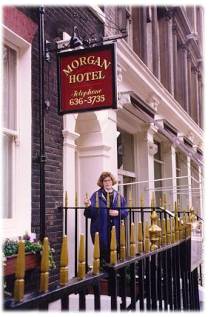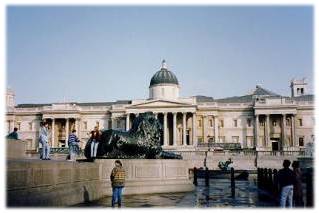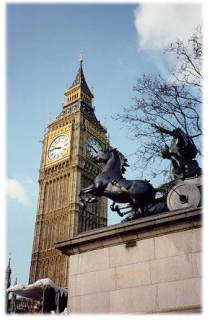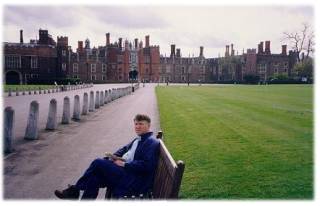
|
We stayed at the Morgan House
Hotel, located on Bloomsbury right around the corner from the British Museum.
This hotel is very much like dozens of others right down Gower Street. But
the price was right and the location was wonderful. The British Museum can
be one of the most overwhelming tourist visits in the world. There is so much
to see that the visitor can easily become exhausted making an effort not
to miss anything. We enjoyed staying at the Morgan because we were able to
make several short visits to the Museum, concentrating on one area at a time.
At any time we became tired, the hotel was just three minutes away. We have
always believed that the most important consideration in choosing any place
to stay is location. |
| Trafalgar Square, London's
most famous, is heavily populated by Londoners, tourists, and (especially)
pigeons. Nelson's Column stands in the center surrounded by fountains. The
great streets--Whitehall, the Strand, the Mall, and Pall Mall--come together
at the Square, and on its edges you can visit the National Gallery or St.
Martin-in-the-Fields. |

|

|
Right at the end of Westminster
Bridge on the Parliament side stands a statue of Queen Boadicea riding her
war chariot and surrounded by her daughters. This Icenian queen led an uprising
against the Romans in 60 A.D. but poisoned herself after it failed. Rising
above her is the tower housing Big Ben. On my first trip to London, I learned
that Big Ben is not the clock, nor is it the structure itself. Instead it
is the Great Bell of Westminster which was hung in the tower in 1858. Today
tourists can visit sessions of Parliament, but we have never had the time
(nor the inclination) to do so. |
| The Tower of London is the symbol
of Britain's past, a time when heads could roll at the whim of a king. The
Yeoman Warders (the Beefeaters) provide an interesting guided tour of the
complex for those who are interested. Tourists can also write ahead and get
tickets to the Ceremony of the Keys that takes place each night at 10:00.
Don't be discouraged if there's a long line at the entry point or at the Jewel
House; in both cases, the line moves pretty fast. |

|

|
We have never figured out
what all the different guards represent. Everyone enjoys stopping on the walk
down Whitehall and patting the steeds of the Queen's Life Guard. I suppose
that the only function these horses serve is that of "live photographic
opportunity." As for the guard in this photo, I'm not sure where he's placed.
We saw similar guards at two or three of the buildings in the center of the
city. There are a couple of places that one can observe the Changing of the
Guard. Of course, you can join the huge crowds at Buckingham Palace each
day, or you can opt for the less crowded changing of the Horse Guards in
the court yard near the mounted horsemen. |






